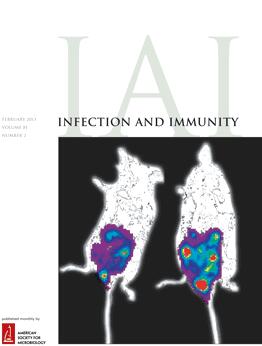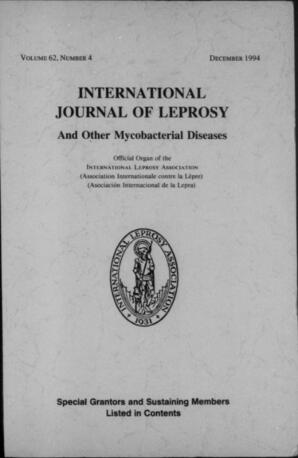Hussain, Rabia
Person Preferred Name
Rabia Hussain
Related Works
Content type
Digital Document
Abstract
Untreated and treated leprosy patients and their household contacts were screened for antibody to Toxoplasma gondii using antigen-coated latex particles. A significantly high level of seroprevalence (29·6%) was observed in the untreated leprosy patients compared to endemic controls (P < 0·01) with a mean reciprocal antibody titre of 20 007 ± 3580 (n = 98) in seropositive patients. In treated patients seroprevalence dropped to 13·5%. Seroprevalence in a group of household contacts of leprosy patients was similar to that of control subjects from an endemic area but not exposed to leprosy (7·8% and 6·1% respectively), indicating that the increased seroprevalence in leprosy patients was not merely due to increased exposure related to socioeconomic factors. Antigenic cross-reactivity between T. gondii and Mycobacterium leprae antigens was ruled out by cross inhibition experiments carried out with soluble antigens from each of the organisms. We believe these antibodies may be induced by an increase in T. gondii load in leprosy due to a transient reactivation of latent T. gondii infections, as the antibodies in these leprosy patients were not associated with any sign of eye or lymphatic pathology related to toxoplasmosis.
Origin Information
Content type
Digital Document
Abstract
To study responses to Mycobacterium leprae antigens, we developed an in vitro model system in which latex particles coated with M. leprae sonic extract (MLSON) antigen were presented to monocytes. Uptake and oxidative response as measured by superoxide production to these antigens were investigated. Phagocytosis of MLSON-coated particles was greater than that of control particles in monocytes from both leprosy patients and controls from leprosy-endemic areas; uptake of MLSON-coated particles was higher in monocytes from lepromatous leprosy patients than in cells from tuberculoid leprosy patients and controls. In both patients and controls, uptake of latex particles coated with leprosy antigens triggered very little reduction of nitroblue tetrazolium although the cells were capable of mounting a respiratory burst. Antigen-coated latex particles can therefore be used as a tool to investigate monocyte responses to M. leprae and individual recombinant antigens.
Origin Information
Content type
Digital Document
Abstract
Quantitative enzyme-linked immunosorbent assays detecting IgM to the soluble Mycobacterium leprae crude sonicate (CD75) and the synthetic disaccharide antigen coupled to bovine serum albumin (ND-BSA) were assessed for their ability to determine early infection in families/household contacts of leprosy patients and employees of a leprosy center working in close contact with leprosy patients. Although IgM to both antigens (CD75 and ND-BSA) correlated with the bacterial index (BI) assessed histologically on skin-biopsy samples, the level of IgM antibodies to ND-BSA was a much more sensitive indicator of low bacterial loads. A 4.4-fold difference in antibody levels was observed between the mean group levels of endemic controls (N = 116) and tuberculoid leprosy patients with a BI of 0 (N = 88), increasing to sevenfold in tuberculoid leprosy patients with a BI of 1 (N = 20). Using a statistical cut off with endemic controls (mean + 2 S.D.), household/family contacts showed 30% seropositivity (N = 180) as compared to staff contacts who showed 17% seropositivity (N = 55). Percent seropositivity in family contacts was not related to the type of leprosy of the index case (lepromatous vs. tuberculoid) or the duration of treatment of the index case. Age of the individual in the family contact group had a significant influence on seropositivity. These results support the hypothesis that, in this community, factors other than the viable bacterial load of the index case, such as genetic susceptibility, may be influencing the high rate of seropositivity in family contacts. IgM ND-BSA antibodies seem to provide a good indicator of low antigenic loads and could prove to be useful in detecting subclinical infection before the onset of dis-ease. Follow-up studies of these seropositive individuals are in progress to understand the relationship between seropositivity and the progress of clinical disease.
Origin Information
Content type
Digital Document
Abstract
A one-tube nested polymerase chain reaction (PCR) method for the diagnosis of paucibacillary leprosy was developed using the repetitive RLEP sequence as a target. Detection of the PCR products was simplified by the adaptation of a colorimetric method. The test was specific for Mycobacterium leprae, and the sensitivity of the assay was 1 fg of purified genomic M. leprae DNA (less than one genome). Complete concordance was seen between the development of color and resolution on agarose gels. The results of frozen skin sections from untreated patients showed that the assay could detect 100% of multibacillary samples [bacterial index (BI) of 2 or more] and 69% and 70% of the samples with Bis of 1 and 0, respectively. The use of one-tube nested PCR in assessing the effectiveness of multidrug therapy (MDT) in leprosy also was determined. The simplified colorimetric assay was found to be sensitive, rapid and specific, and is suitable for use in routing diagnostic laboratories.
Origin Information
Content type
Digital Document
Abstract
Sixteen out of 45 (36%) leprosy patients with clinical features of acute erythema nodosum leprosum (ENL) did not show the characteristic presence of neutrophils (polymorphs) in histology of the ENL lesion. The acute-phase reactants, serum amyloid A (SAA) and C-reactive protein (CRP) which are systemic markers of inflammation, and IgM and IgG antibody to Mycobacterium leprae were determined in these patients in order to understand the differences in histological diagnosis. Both SAA and CRP were elevated in ENL patients, irrespective of the presence of polymorph infiltrates, as compared to nonreactional lepromatous patients, patients with histologically confirmed reversal reactions and endemic controls, indicating that all clinically diagnosed ENL patients had ongoing inflammatory reactions. On the other hand, IgM and IgG antibodies were significantly lower (> 70%) in ENL patients as compared to nonreactional lepromatous patients. When the two ENL groups [ENL-PMN + ve (positive for neutrophils) and ENL-PMN -ve (negative for neutrophils)] were compared, there were no significant differences in the mean SAA, IgM or IgG antibody concentrations, but CRP was eightfold lower in ENL-PMN-ve as compared to the ENL-PMN+ve group. This may indicate that the timing or modulation of the reaction was different in the two ENL groups. Thus, measurement of the acute-phase response and the ratio of SAA/ CRP in particular are helpful in the clinical diagnosis of ENL reactions in leprosy.
Origin Information
Content type
Digital Document
Abstract
Protection against Mycobacterium tuberculosis infection is dependent on T cell and macrophage activation regulated by cytokines. Cytokines and chemokines produced at disease sites may be released into circulation. Data available on circulating cytokines in tuberculosis (TB) is mostly on pulmonary TB (PTB) with limited information on extrapulmonary disease (EPul-TB). We measured interferon-gamma (IFN-γ), interkeukin-10 (IL-10), CXCL9 and CCL2 in sera of patients ( n = 80) including; PTB ( n = 42), EPul-TB ( n = 38) and BCG vaccinated healthy endemic controls (EC, n = 42). EPul-TB patients comprised those with less severe (LNTB) or severe (SevTB) disease. Serum IFN-γ, IL-10 and CXCL9 levels were significantly greater while CCL2 was reduced in TB patients as compared with EC. IFN-γ was significantly greater in PTB as compared with LNTB ( P = 0.002) and SevTB ( P = 0.029). CXCL9 was greater in PTB as compared with LNTB ( P = 0.009). In contrast, CCL2 levels were reduced in PTB as compared with LNTB ( P = 0.021) and SevTB ( P = 0.024). A Spearman’s rank correlation analysis determined a positive association between IFN-γ and IL-10 (rho = 0.473, P = 0.002) and IFN-γ and CXCL9 (rho = 0.403, P = 0.008) in the PTB group. However, in SevTB, only IFN-γ and CXCL9 were positively associated (rho = 0.529, P = 0.016). Systemic levels of cytokines are reflective of local responses at disease sites. Therefore, our data suggests that in PTB increased IFN-γ and CXCL9 balanced by IL-10 may result in a more effective cell mediated response in the host. However, elevated inflammatory chemokines CXCL9 and CCL2 in severe EPul-TB without concomitant down modulatory cytokines may exacerbate disease related pathology and hamper restriction of M. tuberculosis infection. [ABSTRACT FROM AUTHOR]
Origin Information



